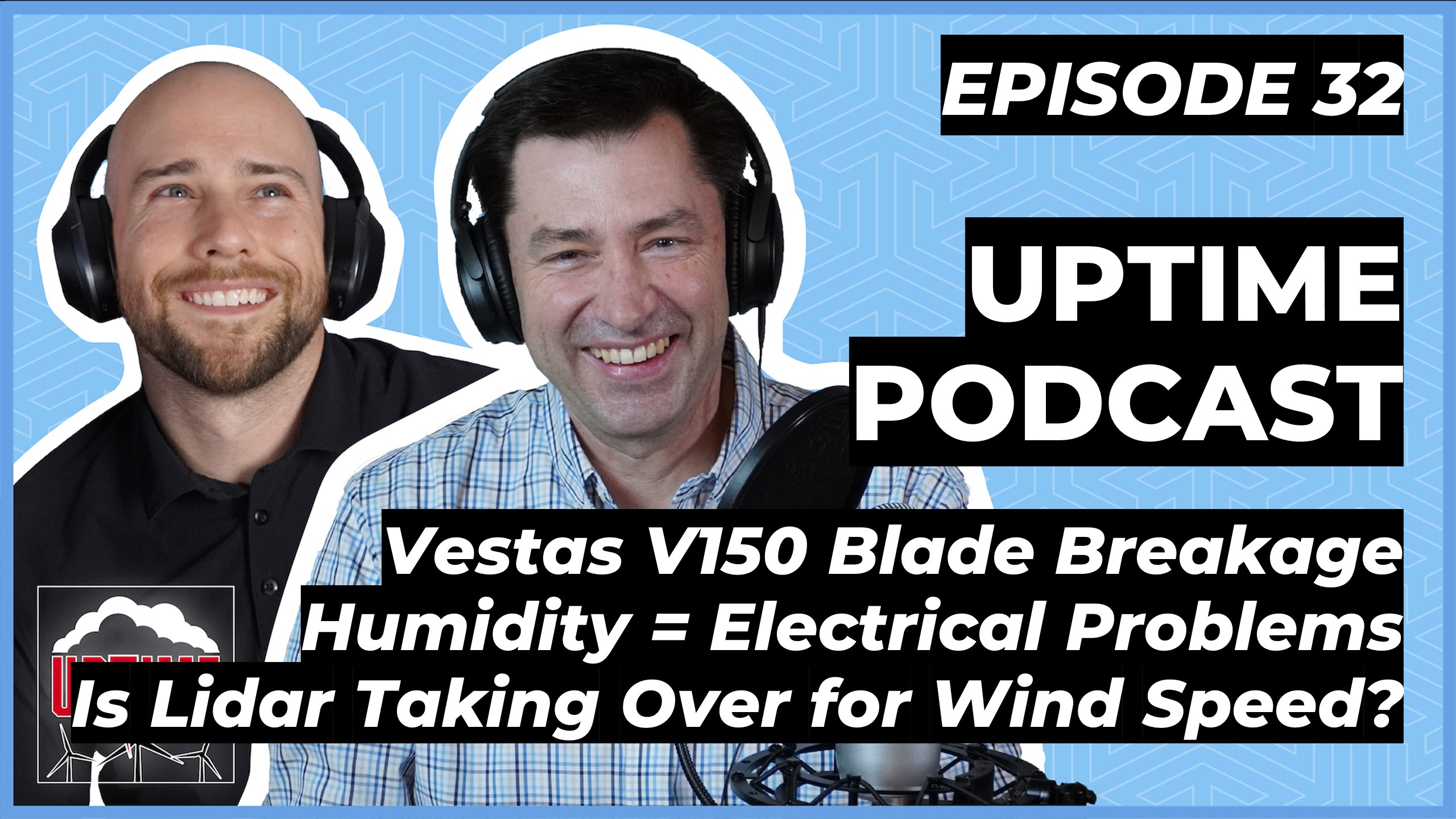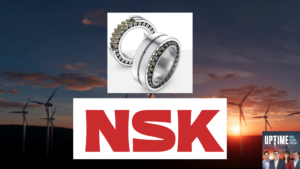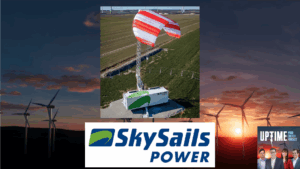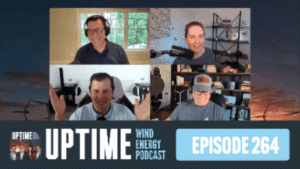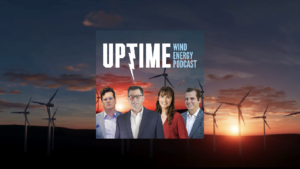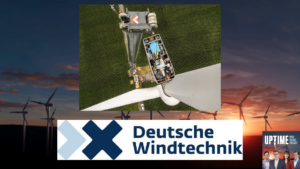A Vestas V150 blade broke and fell to the ground in Iowa, resulting in 46 turbines being stopped for a root cause analysis. Humidity within a wind turbine can cause significant electrical issues; we discuss solutions for keeping turbines dry, even off-shore. ZX Lidar has been approved for Siemens Gamesa turbines, so we talk through the implications of lidar as a primary measurement tool for wind speed.
Learn more about Weather Guard Lightning Tech’s StrikeTape Wind Turbine LPS retrofit. Follow the show on YouTube, Twitter, Linkedin and visit Weather Guard on the web. Have a question we can answer on the show? Email us!
Podcast: Play in new window | Download
Transcript: EP32 – Vestas Blade Issues Continue; Humidity Causes Electrical Problems; Lidar Wind Turbine Speed Measurements
This is the uptime podcast on today’s episode. We are going to chat in our first segment about news. We’re going to talk about Vestas blades that are still having problems. It sounds like at this point, they’re going to shut down a bunch of turbines in a large wind farm. And so Iowa is kind of like the hotbed for investigatory, um, analysis here.
So we’re going chat about that a little bit. And our engineering segment today, we’re going to talk about. High humidity and some of the issues that can cause especially in offshore wind, uh, LIDAR, this is a not new technology obviously, but the application here, uh, on measuring wind turbine speed, especially in remote locations is really interesting.
And lastly, we’re going to chat a little bit more about fires and some of the reporting it and some of the, uh, Implications for people’s emotions, getting in the way and not allowing their reputations, perhaps to be damaged by saying, Hey, we have had a fire here and, you know, we need to return that, that data to the, uh, the rest of the world.
So, Alan, let’s jump into Iowa and Vestas. So V one 10, two megawatt. Wind turbines seem to be having some problems.
Allen Hall: They are, it’s surprising because it’s, it seems like it’s relatable to that particular turbine or lightning and the lightning protection system from news reports, local news reports in Iowa.
They seem to be focusing on the lightning protection system. And in fact, they’ve shut down about 45 or 46 turbines in which have indications of lightning strikes near them or to them. Because they’re concerned about the subsequent structural damage, internal damage to these blades and whether it’s causing some other catastrophic effect, because blades breaking off is, is really catastrophic from the structural standpoint.
I, I don’t know the question really right now is what. Is the possible failure mode. Is it really lightening or is it high winds? Because with lightning strike tends to come high winds, thunder storms bring high winds, and we can sometimes confuse that we’ve had a recent lightning strike with also having a recent storm pass through and we we’ve overloaded the AA structure.
And then didn’t notice the internal damage that was caused the blade. Don’t you think that some of this may be just straight? Hi. Hi. Hi wins. At this point, Dan is just, seems like there’s just too, too many of these issues.
Dan: Yeah. That’d be really curious to see what happens in the root cause analysis when they come back with, you know, a, you know, a reason that this is all happening, but yeah, it seems.
I don’t know, kind of implausible that lightning is destroying so many of these, right. I mean, they’ve had a couple of now they’re just really nervous that there’s some underlying defects, so they want to check them all. But yeah, there’s too many turbines around where if lightning was causing this many to fail, it’d be more of a problem somewhere else.
So it seems more just like a, either a manufacturing defect, which they probably realize that that’s a piece of it at this point or. You know? Yeah. It just doesn’t seem like lightning, even though it obviously is an expensive problem to fix it doesn’t seem like lightning. Shopping blades in half that often.
Right? So there’s something else in play.
Allen Hall: These blades are too short to have carbon fiber and carbon fiber is always the seen as the weak link because it is conductive enough to carry lightening energy. The end, if you have a down conductor system, which almost all blades have that if you have a Dow conductor system and carbon fiber, that there can be some.
Bad sparking between the two, which can damage a carbon fiber, or you can overheat the carbon fiber. And he caused later damage to appear just because of the fatigue on the blades, but on these shorter blades and a V one 10 is not a small of late, but it in relatively speaking, it should just be an all fiberglass blade with a copper down conductor in the middle of the blade.
And there’s really nothing structured that should happen there unless the copper and then the copper just exploding me. There’s, there’s only a very limited subset of things that can happen inside that play. That would cause that kind of structural damage, which, which leads me to believe that it’s not necessarily a lightening issue as it is a high speed Hyde high wind situation, which will break blades.
We know that we’ll break blades and also. Kind of wonder if this is everybody’s just being super cautious because they know Vestas has been dealing with a lot of, uh, lightning repair. They had that $175 million, uh, repair bill to fix a number of winter and blades. So your, your first thought goes to it’s some sort of lightening issue, right?
May maybe may not be, but with this winter and company, and I was essentially shutting down 46 wind turbines, and I had gone to go inspect all those, which is going to take awhile. Maybe they can see internal damage to these plays are truly correlated to what the real driver is. And I just have a hard time believing it’s lightening.
It seems, it seems like a sports wind speed. Or, or a manufacturing defect. I mean, it could be a manufacturing defect.
Dan: Yes. Can you speak a little more to the carbon fiber thing? I think that sounds counterintuitive where you’re saying that this is surprising that, you know, because these are our fiberglass, they should be more durable than carbon fiber.
That seems counterintuitive because obviously everyone knows that. Carbon fiber is, is incredibly strong and yet lightweight material. So can you just speak to why you’re, you know, if this was made of carbon fiber, you’d be more likely to accept that it was lightning damage.
Allen Hall: Well, carbon fiber is lightweight and it is extremely strong, but it is slightly conductive.
It’s not as conductive as a piece of copper would be okay. But it is conductive. And we, we make all kinds of structures out of carbon fiber that handle lightning energy aircraft are designed with carbon fiber all the time and handle lightening energy. What the issue is with carbon fiber, uh, and the, and the resin systems that are encapsulated.
And so it’s not just the carbon fiber, but it’s, it’s the epoxy system or whatever resin system you’re using for the blade because carbon fiber can carry some lightening energy and carbon fiber. Doesn’t really care. I mean, carbon fiber is essentially burnt material, but the resin system doesn’t like getting hot and carbon fiber is very pretty.
It’s kind of resistive. So as you shove lightening energy down carbon fiber, it gets hot in the resin system gets over tempt. Uh, it may vaporize the resident system locally because the temperatures get so hot. And once you do that, you degrade the structural integrity of the blade. So having carbon fiber there provides a pathway to distract.
To degrade the residence system. I E the structure of the blade fiberglass won’t do that. Fiberglass is not conductive. So either you’re going to punch a hole through it from lightening and cause some sort of explosive effect or, or, or nothing’s going to happen because it can’t conduct the lightening energy.
So in a way, fiberglass is a lot more, uh, conducive to controlling lightening. Then the carbon fiber blades are, it’s all about the design. The issue in this particular case where you have a, what should be a completely fiberglass blade design. When you have blades get severed somewhere down near the rut or the hub, those structures down there are massive, massive, uh, fiberglass structures.
It makes other things seem tiny and they’re just, they’re just so thick and there’s no way that. Lightening energy can travel through them, less it punctures through them. At that point, it’s so thick. It probably doesn’t do that. Uh, so to have them break down there that hub base area indicates that there’s something else going on, probably not lightening.
And I know we have been involved in a couple of other projects where there have been some questions about lightening strikes causing. Uh, blade tip separations and some other things. And it turned out just looking at the raw data. When you start looking at all the data, you realize that the wind speeds were really high relative to having a thunderstorm pass through.
Uh, so lightening didn’t correlate to damage wind speed, sorta correlate to damage. And this is the thing that, uh, Alex Byrne brought up from DNV GL. The other day, when we had him on the POC, had her on the podcast was we don’t have really good measurements for wind speed. On the turbines. So if you do have a high speed wind event, and you say it’s a localized or say, especially in Iowa and the Midwest of the United States where you’re gonna have tornadoes or cyclical, wind activity, that’s local very, very local.
Uh, there’s really no way to detect that you wouldn’t detect it, except that you would have. Structural damage to your blades, but you wouldn’t have any data to go back and look at it necessarily. And that’s the trouble. And that’s what Alex was pointing out is that a lot of times we assume a certain kind of failure mode, but because of the lack of data, we really aren’t are not sure.
And one of the key pieces to determining if we have two high wind loads is to have some we to measure wind speeds,
Dan: which we’ll cover a little bit later too, with the LIDAR stuff. So that’s an interesting development there, but. It is. Yeah, you’re right. I guess the worst scenario is that this comes back inconclusive where, you know, it could be any of three possible scenarios are a confluence of factors and.
That’s probably the worst. I’m sure. At this point, they’d like to just identify that it was, it was this like, so let’s just move past it, but
Allen Hall: let me be devil’s advocate here for you. Dan, there are 46 wind turbines that have either taken a lightning strike or near lightning strikes. So they’re on your list of watch.
Okay. You’re going to send a crew out or multiple crews out to go look inside each one of those blades to see, or on the outside of blade and the inside of the blade, probably to go see if there’s some sort of structural defect. You want to do that once. Right? So there’s 46 blades. One time say you come back and you say, you know, I don’t really see anything.
W is that the last time you look at them, probably not. You’re probably going to be back there every two weeks, every month because local government officials are going to ask you to keep checking those blades, to see if it’s a fatigue problem. Right? So your best case situation is you identify relatively quickly what this issue is.
Otherwise you’re going to be expecting 46 times three blades for the foreseeable future, which if you’re the poor technician that has to do that, that’s not an enviable job, no way.
Dan: Yeah. So obviously this is not a huge sample size. Like Vestas had a V1 50 blade break off an Ohio site recently. You know, we talked about that, you know, I feel like in today, you know, this is just like you compare celebrities today, celebrities back in the past, like it’s not like celebrities were getting in less trouble personally, you know, like getting caught, doing weird things in their personal life.
They just there’s this Twitter ever. There’s a phone on everyone right now. So you can’t do anything as a celebrity and not have someone film you doing it. Right. Right. And today, you know, like it’s not clear how big of a sample size this is because every blade failure is going to get reported on, like, it’s a big deal.
It’s a cool photo. It’s very Ooh. And, ah, right. So yeah, I mean, there’s, there’s been a couple recently, but as we all know, with just like random chance and variants, if you have 10,000 blades and you know, like. Say 10, you know, 1% is that 1%. Now it’s a point, 1%, uh, are going to fail. Then you could have 10 fail all in the one month period and then none for the next nine years, or you could have them all evenly spaced out one per year, over 10 years.
You just don’t know. You could just run bad, just like playing poker or anything else. So it’s, it’s, it’s still a small sample size and it’s hopefully not a big deal. And they’re like, yeah, maybe we just had a weird isolated incident where he just had a bad string of, you know, in the news and a couple broke all at once, but we should be fine.
Yeah, you just don’t want to, like, you won’t really know until they finished that root cause analysis.
Allen Hall: Yeah. And there’s roughly just to get your head around it. There’s about 60,000 wind turbines in the United States, which means 60 times three is 180,000 blades. So having. A blade or two break is really, really down on the noise in terms of, of, uh, percentage wise.
And it, it starts to get to that variability. Is it just random breakage? Not that that’s good, but is it just random and just cluster together because we have some high wind speeds and localized areas that are causing this quote unquote cluster to appear, but it’s not real, it’s not a structural issue as, as much as, uh, we’re not able to really monitor the winds as much as we can.
And yeah, and then we have this, something that seems much more severe than it really is.
Dan: so moving on to our engineering segment here, Alan, let’s talk about humidity. So this is an interesting. Article posted on LinkedIn by Michael home. He’s the chief commercial officer from coats. They’re a company that makes you modifiers. Uh, so he’s just talking about some of the things his company does and how much of a problem humidity is inside wind turbines, especially out at sea, which is a really interesting, um, thing to think about because I think he’s absolutely right.
That condensation you’ve I mean, you said they’re re they’re removing sometimes seven liters of water. Per 24 hour period from the air inside of a turbine, which is crazy to think about it’s a lot of wet air, but when, obviously when that condenses on all the metallic, you know, services within it, that can cause shorts and all sorts of electrical problems, not, not even including corrosion, all that stuff.
So obviously you’re an electrical engineer. How big is this? How big is this problem of humidity? And is it often talked about
Allen Hall: it is in the electrical world because, uh, condensation, particularly salty, condensation, or conductive, which is what it is. Conductive condensation is bad for electrical circuitry.
And in a lot of instances, if you open up control cabinets, what you’ll see electrical control cabinets as you’ll see plastic covers and, uh, protects, it means to prevent drips from falling in bad spots. Uh, so it’s one thing. If you’re having condensation on the tower inside the tower and it’s running down the size of the tower, it’s another thing.
If you have condensation in a control cabinet and you have. Exposed electrical wiring, or I suppose electrical components where it can affect the performance of the circuitry. That’s a big, big, big problem. And, uh, the condensate, because it’s obviously gonna depend on what part of the world you’re in and what the temperatures are and what the relative humidity is.
Okay. And as we get to colder climates, especially it was salty air and you get a warm day, cool nights kind of things sort of happening. You can get a lot of condensation inside of wind turbines. We see a very similar thing in aircraft, and I know it’s hard to think about an aircraft, but you know, aircraft flies at 30, 40,000 feet gets really cold soak.
And then we’re all going to Disney world are flying through, you know, Miami Fort Lauderdale, right? Orlando areas and that cold soaked airplanes, all the water starts to condensate inside of it. And if you’re in the right part of the airplane, the back part of the airplane, it’s like, it’s raining in there.
There’s that much condensation pouring
Dan: down. That’s
Allen Hall: so weird planes. Yeah. It’s really serious. And if you feel, look at a lot of the, if there’s electrical power circuitry and things like that in those uncontrolled atmospheric areas, There are covers and protectors to prevent the water, to go into bad places and to drain it out.
And there’s all kinds of floor drains all over aircraft to suck the water up. Cause there’s a lot of condensation because it’s, it’s getting cold soak and it’s flying into high humid conditions. So there’s just condensation happens. You’re going to have that same sort of effect. Not. As severe on a wind turbine, but you know, the tower wind turbines made out of metal.
So it’s thermally conductive, very thermally conductive. So whatever the outside temperature is, is pretty much what the tower temperature is. And if the right combination you want to get condensation and that’s bad. So there’s really two ways of. Combated, uh, try to, uh, well, and then in this particular case, what they’re doing is they’re drying out the air, cleaning the are trying to desalinate the air and shove clean air in it.
Which is probably the best solution and the solution just basically put a dehumidifier in there and just try to suck as much water as there as you possibly can. Uh, but don’t you think, as, you know, kind of go back to our discussions with DNV GL, as argument made about, uh, all kinds of systems that as the, the megawatts increase in the cost of the turbines increase.
The relative costs of dehumidifying systems, lightning protection systems, fire, suppression systems, all those other things become relatively small, not nine consequential, but smaller that it’s time to put those systems in just to keep this equipment up and running longer, because I can’t imagine
Dan: perfect analogy.
I got renter’s insurance on my laptop because I work on my computer for a living. And as you know, recently I got a new Mac book, uh, air, and like seven days later left a water bottle, the cap a little bit open and it filled my new laptop with water. So I learned this valuable lesson that electronics don’t love water because it certainly didn’t turn back on after it was filled to the brim with water.
And I learned that the risk of paying 40 bucks a year for a laptop insurance was very worth it because now I didn’t have to shell out another $1,200 for a laptop, so, right. Perfect analogy. It sounds like this was just meant to be to happen. So we could re you know, relate these two stories here on the podcast.
Um, but yeah, no, you’re right. I mean, if this is a, I have no idea what these humidifying systems cost, but, you know, if you just end up having major circuit. Issues and major parts breaking because of condensation, all that, then they’re not worth it. Yeah.
Allen Hall: Located air conditioners. Right? If you chill the air, you’re creating condensation on coils and then you’re taking the water and dumping it over or board, and then you put a filter behind it to hopefully suck out some of the dirt and the CRA that wants to blow in.
So what’s, you’re pushing in dry or air. You’re forcing out the more humidity air all the time. Uh, it’s just like the way a cleaned room room works. You filter the air, you pressurize a room and all the dirty air on the outside gets pushed away from the room the whole time. It’s a similar sort of concept.
So it can’t be all that expensive to do, because like I said, it’s, it’s fundamentally an air conditioner. So I think relatively speaking, it probably makes a lot of sense. Long-term to put in a dehumidifying system,
Dan: interesting article out there from coats and mr. Holm who worked for the, the coats company.
So. Uh, moving on ZX, LIDAR has been approved for use on Siemens, COMESA turbines, and their website’s really interesting. It says they can the accuracy. So these, these I’m getting ahead of myself here. The LIDAR can measure wind speed, especially in remote locations. Right. And they can apparently get it, get it right within plus or minus one meter per se.
0.1 meters per second, which is very accurate and wind direction to plus or minus 0.5 degrees. So half a degree. So, Alan, how has this technology work? What are they measuring and how how’s this whole thing tie into making wind turbines.
Allen Hall: So it, it works in a various similar way too. Well, the radar work or any sort of radar, if you think about, uh, the most simple form of radar, you watch on television and they’re showing the storms coming in, you can see the colors change what, and in the, in the weather radar situation, what they’re actually doing is they’re sending out a pulse of RF energy.
Out to the sky. And some portion of that gets reflected back and they measure the time Delta to travel out and to travel back. And the intensity of that signal on the backside to then determine how intense that storm is and how far away it is. So think of doing the same thing, except with light lasers.
But instead of bouncing the energy off of water particles in the cloud, you’re essentially bouncing it off the dirt and the crud that’s in the air. So they’re, they’re, they’re measuring their reflection back and the time it takes to go from a to B, uh, off of dirt particles in the air to determine how fast and what direction the air is blowing.
It’s really ingenious technology because it’s not just measuring it in one particular spot. It can measure it in a lot of different locations simultaneously or nearly simultaneously. Uh, so it gives you a real good picture of what the wind looks like coming into the turbine. Now, why do we care? Right.
Why, why are, why do we even want that data? Well, one, you can verify the efficiency of the turbine. If you know exactly what the wind speed is and its direction, you can tell if you’re pointed correctly into the wind, something you need to know, and then you can look at your power curves versus the wind speeds and see are we actually generating the amount of power that we should be at this particular wind speed.
Those are really important things to know. If you’re looking to maximize the efficiency of your wind turbine. The other thing that it can allow you to do. And it depends on how far the LIDAR can see out in front of the turbine is if you do have a tornado NATO situation or hurricane typhoon, any, any sort of high wind twisty, wind sort of event, uh, you can give the wind turban a little bit of a heads up.
On the control system side and say, Hey look, a big wind gust is coming. Let’s feather the blades so that we don’t take the full blunt of the wind load on the, on the blade structure and maybe do some structural damage, uh, or to dampened, to dampen the effect onto the, the load into the tower and all kinds of things.
Uh, if you know, what’s coming, it’s like bracing for like in football, you see alignment coming at you. You sorta brace up and get ready to take that. Hit
Dan: the winter. You can call your call your wind, your wind turbine children, and tell them you love them. Because they’re not just might be, this might be it for you.
The farm might be gone.
Allen Hall: Right. Well, and I think it has always been a go back to Alex Bird again, which she was really about. We need to have more data of what’s going on on each of the wind turbine sites. So we can then analyze the data properly. And with LIDAR, you’re going to get a lot of data. Very.
Accurate data to determine the efficiency, if you weren’t ever in system one, but also maybe to prevent some of these structural damage events from happening, which is super important. So again, as the wind turbines get larger and they come, uh, more expensive to install, it starts to make sense for some of these.
Delta is small systems safety’s features to be installed to protect your investment. And I think LIDAR is one of them. That’s why you see Siemens, Gamesa, Bessie blessing a particular, uh, version of a LIDAR system as being good for this wind turbine. And probably because it interfaces with our control systems, I’m guessing, and that’s probably a part of the deal is integrated into the system.
Dan: Yeah. And this version is the, the ZX TM. So, um, and they said, you know, it has to be agreed on by the customer, whether they can use the both parties need to say, okay, we’re fine with verifying, um, you know, the speed with LIDAR instead of the, you know, the mast and the anemometer. So,
Allen Hall: yeah. Which is a very clunky system and that’s a 19.
10 ish, 1880, cut a wind vane on top of the barn system of detecting wind direction. A wind speeds. It’s antiquated because it’s not accurate and it’s measuring it after it goes by the blades. So the event has already happened when or to the, to the load. So if you do have some sort of high wind micro burst kind of event, it’s already too late.
By the time you measure it, the winds are a buyer. So you can’t react to it versus a LIDAR, which you can see out front and then adapt, which is a huge Delta in terms of increasing blade, longevity and blade safety and efficiency and all kinds of other things. Uh, it just makes sense to get to a LIDAR.
Dan: So our last topic for today, Uh, interesting article from windpowermonthly.com. Just talking about under reported. Uh, wind turbine fires. And the headline here is fire as a wind farms, underreported over fears of reputational damage. So this is something I think we’ve talked about sort of as a recurring theme that, you know, a winter of manufacturers are keeping all of their data close to the vest.
So you don’t really know who’s solving what problem, how right they don’t want to. And it seems like that’s kind of hurting everyone’s ability to grow as an industry. Like, Hey, we could share a little bit of a data or a little bit of our data. Then we could solve some of these problems together and move forward.
But also this is just getting into the human psychology a little bit where people don’t really want to admit that they’re having problems. Right. And it just goes beyond the data. You know, there’s no like data secrecy issue there. They just don’t want to admit that. Yeah. Maybe when energy is not as, uh, safe, I mean, it is very safe, but maybe it’s good.
This is all just data that’s saying like that there are issues, which there’s issues with everything. Right? How many car accidents there are there every day? We don’t need to, you know, Screw up the, uh, you know, fudge the data on car accidents. Like we just, we know that there’s a certain amount that happened and hopefully it gets safer over time, but there are car accidents.
There’s, there’s, you know, plane crashes and there’s issues with wind turbines, including fires. So does this surprise you that maybe there’s a little bit of under under-reporting?
Allen Hall: I, I think there’s probably underreporting in terms of they’re claiming with the insurance company that may be part of it. Um, It’s just like an automobile accident or some sort of home accident.
If the, if the damage is low, you’re not going to claim it. So nobody really knows the wiser and you fix it and move on. Maybe not realizing there’s more of a larger root. Problem to what created that fire. And then I think also in the, in the United States in particular, because, uh, it’s a pretty big country and it’s very state and local localized and fire departments tend to be very local also.
And not. Really connected in a sense that there was providing data to the rest of the world. So I can’t necessarily go online and look and say, Hey, what happened in this small town in West Texas in terms of fires? I don’t know if that data is really accessible, uh, and unless a local news station or television station reports, it, you may not have any sort of record of a fire occurring.
If the fire department doesn’t sort of. Broadcast it out. So it’s really going to be really hard to tell how many fires there are, uh, when terms in the United States and the same would exist in Canada and other places that you just don’t really have a reporting system for it. I think the key though is realizing as an industry and this is where.
Uh, groups like ESIG and some of the other groups that are focused on industry needs and industry data and sharing of information, those are the forms in which I think are important in that even in, in the automotive world, I think automotive world, they share data between the manufacturers about general problems, motorists driving habits and that sort of thing.
That if you can share data amongst one another, you can most likely eliminate some of these problems or you can identify them ahead of time so you can address them because with any fire, you have to have some sort of overheat. Situation combined with some sort of fuel combined with oxygen when, which you always have oxygen for the most part.
So you just need that heat and you need that fuel grease, bearing heat, all kinds of other issues can be a problem. And, you know, it’s just. I can get back to our fire suppression systems needed. Well, it depends on how many fires there are and what the cost of those fires are. And until we get a really good handle on what those fires are and how big they are, how expensive are, how many they are, it’s going to be really hard to justify one way or the other.
All
Dan: right. Well, we’re going to wrap up today’s episode of uptime. If you’re new to the show. Welcome. If you’re a regular here, thank you for your continued support. Please subscribe to the show and leave a review on iTunes, Spotify, or wherever you listen to podcasts. Don’t forget to check out the weather guard, lightening tech YouTube channel for video episodes, full interviews and short clips from each show for Alan and all of us at weather guard.
Stay safe and we’ll see you next week.
is downtime causing you financial pain and putting a stop to your power production for months on end. It’s no secret lightning strike damage is a major cause of wind turbine downtime. This damage is preventable with our easy to install, strike tape lightning protection system for wind turbine blades are incredible engineering, build quality materials and edge sealants withstand up to five times more abuse in the toughest weather, enlightening conditions.



